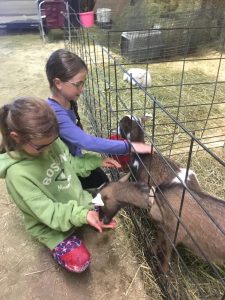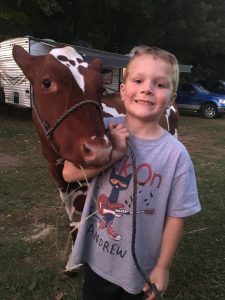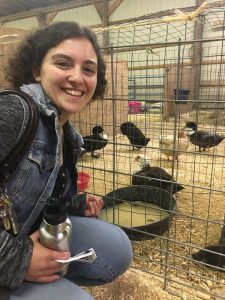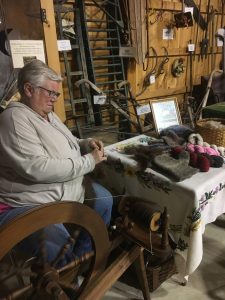By Gwen Baker – Contributing Writer
For many people at the Farmington Fair, the animals are an instant attraction. Fairgoers get to see a wide range of unique animals such as goats, cows and ducks.

Scout and Summit with their mother
(Scout: 8 years, top in purple and Summit: 7 years, bottom in green)
“What’s your name?”
“S-C-O-U-T,” replies Scout.
“And what’s your name sweetheart?”
“Summit.”
“How old are you two?”
“I’m eight,” says Scout
“Seven,” says Summit.
“Why are you drawn to the goats?”
“Cuz they’re cute and fluffy,” says Scout.
“And they’re lickable,” laughs Summit.
“Not likeable, but lickable?” asks their Mother.
“And they’re all different,” Scout adds.
“Do you guys go to the Farmington Fair every year?”
“We don’t come every year, as much as we can,” said their mother. “We live in Livermore.” The mother and the two girls moved down the enclosure to another group of goats.
“These guys like you better,” she said. The goats move towards the girls, sticking their heads through the wire. Both the girls kneel down and began patting the goats through the fence.
“Easy Summit they bite,” her mother advised.
“I know,” she replied.
“Why do you like cows?”
“I first realized how awesome cows were on a family vacation to a farm in NH. I watched a baby cow get born and I also got to milk a cow. I asked my mom if we could get a cow and she said no! Every year during fair season, I try to convince her to let me buy a cow. If I were to buy a cow I would want it to be like a pet dog, it would live inside with me, but I don’t think I would fit inside my apartment. They’re like big dogs and I like dogs… and they lick my face.” She pointed to a baby cow. “I wouldn’t have space for a full grown cow, but possibly a baby. I could fit that size into my apartment. My mom however would not be impressed.” The cow started to lick her face. Laughing hysterically, she told it to stay still so it could pose for the camera. “It’s licking my face… It feels like a cat’s tongue only pricklier,” giggled Beatty.
“How long have you had the cows and what are their names and breed?”
“We’ve grown up with dairy cattle. It’s kinda our passion,” explained Lilly Bagley. “So we have three Milking Shorthorn and one Ayrshire. And we’ve had them for about two years now,” said Bagley. Pointing towards the fence where the four cows were, she began describing the cows.
“I have Rhonda to the left, and Georgia on the right of the pen. And then I have Gargamel, like from the Smurf Gargamel; she’s the brown one and Frozen, (far right) she’s considered a roan, the coloration of her is considered roan.”
4-H is a program that children from 5-18 can participate in and be involved in different projects, from agriculture to arts and crafts to robotics. Most clubs meet once a month and discuss business and come up with plans that members can do in their project.
“My oldest son [Jason] is able to be in 4-H now so he’s able to work with his own animals,” said Bagley. “My husband and I grew up with dairy cattle, went to college and kinda got out of it, then went back into it when the kids were old enough. He’s [Andrew] almost old enough.”
“To participate in 4h, they have to be nine. And then they do little classes for kids five to eight,” said Bagley.
“My favorite thing about raising dairy cattle is the bond that you form between each animal and that each heifer has its own personality.”
“Tell me a little bit about why you like birds?”
“I really have liked birds ever since I took Ornithology my freshman year in college. I took it actually in North Carolina, where I grew up, and ever since I took the class I fell in love with birds,” Shapiro reminisced.
“I’m an avid bird watcher and I love their diversity. I love seeing all the different kinds of birds while I’m out there and though I’d much prefer being out in the field and seeing birds, a lot of the birds that are in here, I have seen in the field.”
She pointed to the duck next to her. “One of which, one of the birds in here called the Muscovy duck was actually very prevalent right near my house and at the campus, I was at where I took Ornithology. It looks kind of funny, so every time I see it, it brings humor I guess you could say. It looks kinda like a combination of a chicken and turkey with warts. I mean it just looks very strange,” Shapiro laughed.
“I love bird watching. I also did a lot of bluebird research for two summers. So bluebirds are my favorite. I wouldn’t call that one my favorite [Muscovy duck], but it brings humor because it looks so funny,” said Shapiro.
“How long have you been spinning?”
“[I’ve been spinning for] twenty-seven years, I’ve been coming [to the Farmington Fair] for thirteen,” said Bolduc.
“What is the process of spinning, how does the machine work?”
“The process is shearing from a sheep or an alpaca, washing and carting it, combing it, then spinning it. I decide how thick or thin I want my yarn to be by thinning it out here. I pull it and thin it out and the spinning wheel twists it. All the spinning wheel does it twist it, and when I’m ready, I let it go. It runs through, it goes through the hole, comes out the others side and runs across these little hooks and winds up at the bobbin,” Bolduc replied, her hands swiftly gesticulating the movements as she demonstrates the process.
“And then when I’m all done I will apply it back on itself, which is twisting the two together, and it will be yarn ready to knit or crochet with,” said Bolduc.
“Does it take practice to get the handle of it?”
“Absolutely, it takes practice. When I first started, I was making rope. It was huge, it was thick, it was overspun. But it’s like anything, the more you do it, the better you get. The more practice. It’s a very touch feel, hands on type of activity. And once you learn how to do it, it’s like riding your bike; you have it forever.” She continued to spin, focusing on the process.
She later mentioned how children on class field trips call the sheep that are colored “Easter sheep.” as well as her amusement when men specifically ask her if they “really have sheep that color.”



